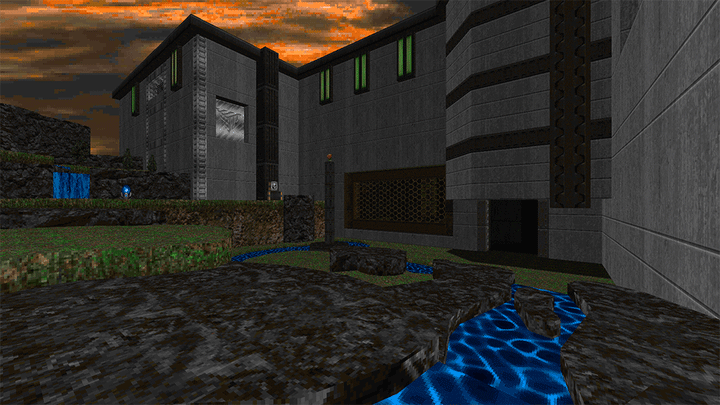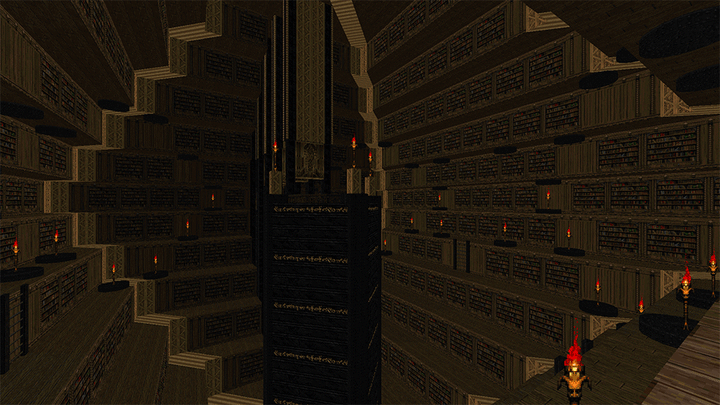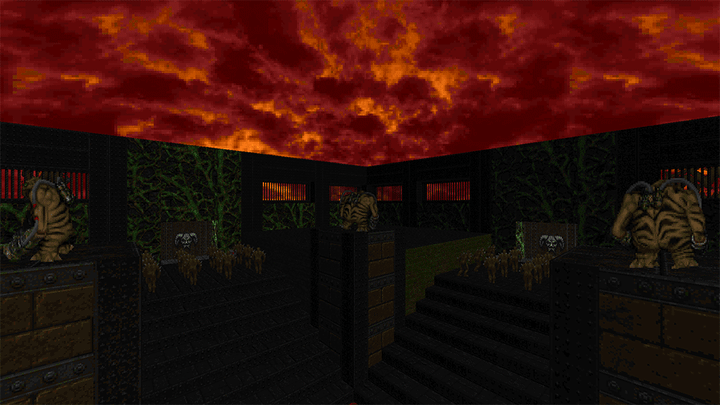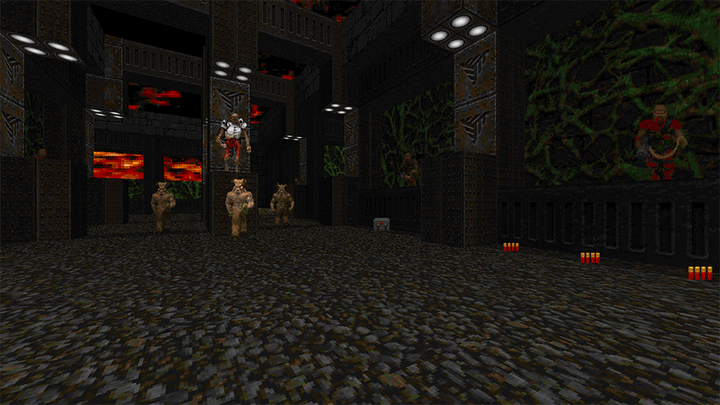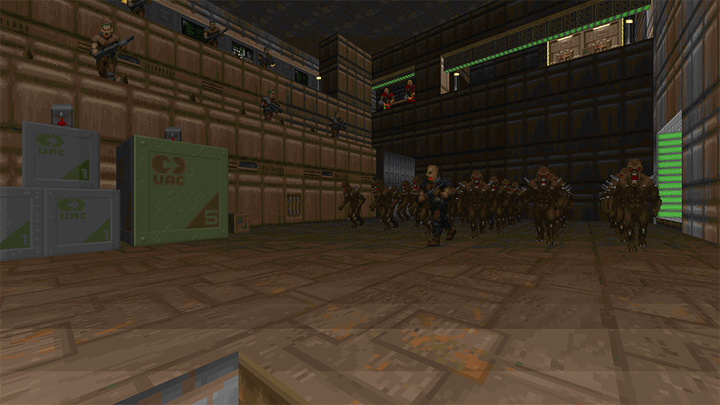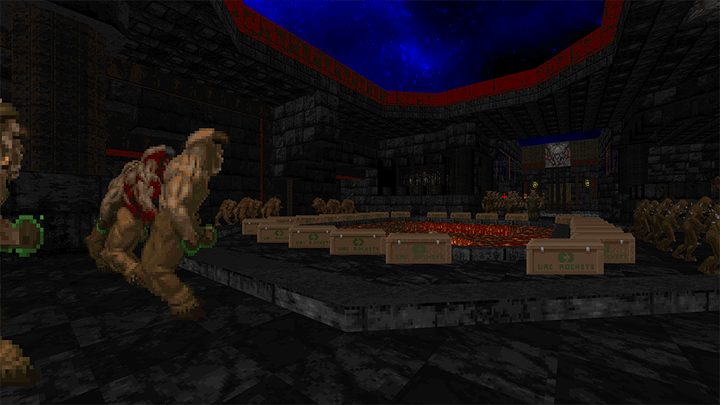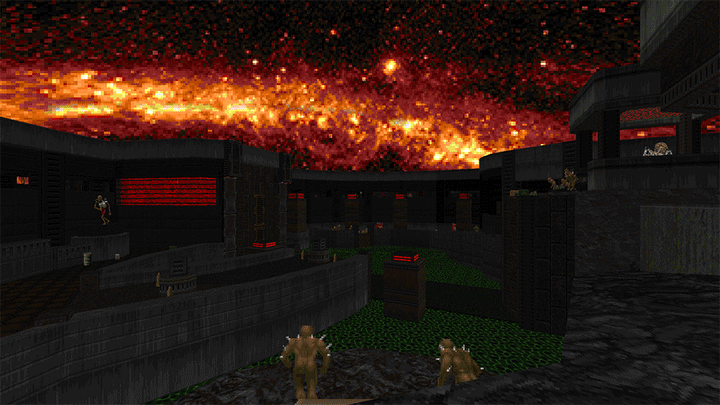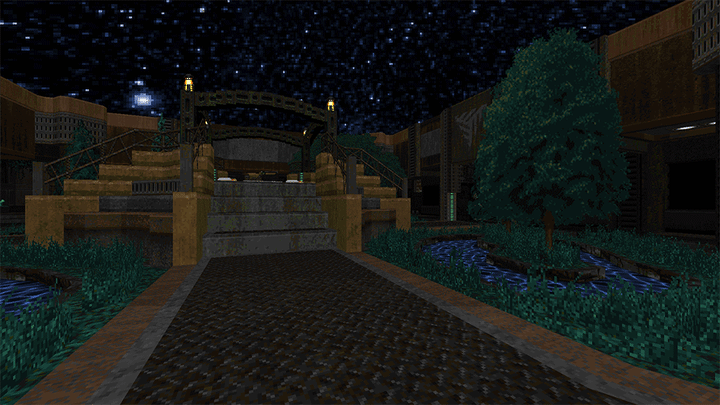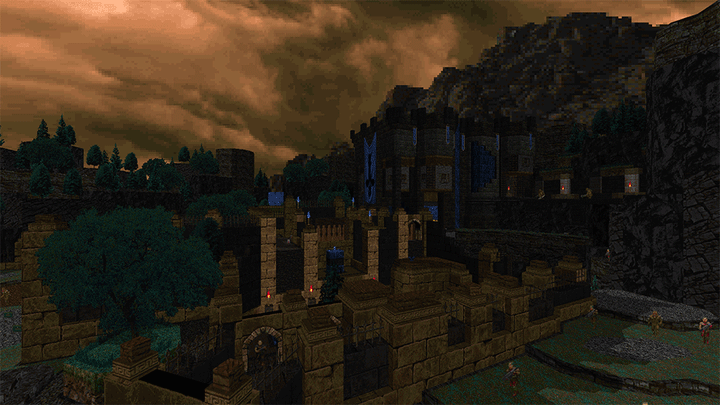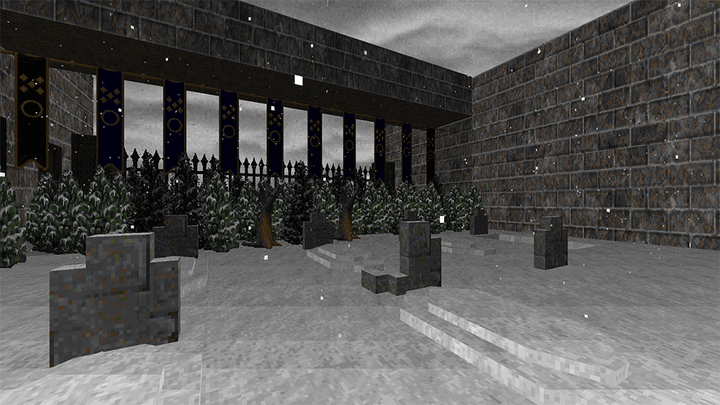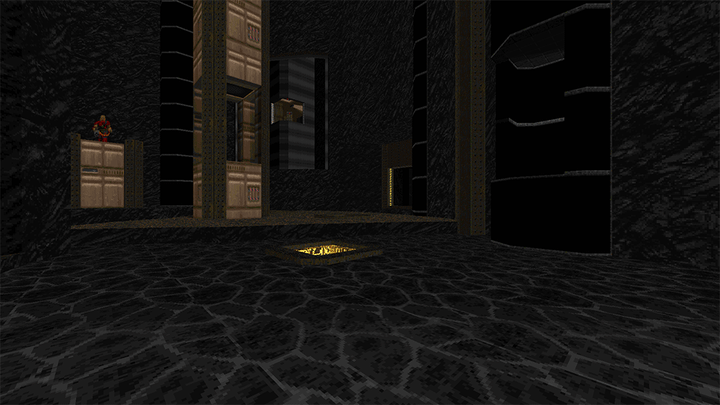Doom Review: Wad Roundup (9th November 2021)
I’ve been catching up with the last few months of releases and here are some reviews and scattered thoughts covering what I’ve tried out so far. I play with dsdadoom on UV, pistol start and record demos of all my initial playthroughs & potential subsequent attempts on any given maps.
Episodes & Shorter Wads:
J.A.M. (Just A Mapset) Episode 1 by Vortale
Did you like Valiant? Do you like fast, aggressive enemies and weapon sets tuned up to match them? If so, you’ll probably enjoy J.A.M Episode 1, 11 maps of boom-compatible, OTEX themed, fast paced combat from streamer & first-time mapper Vortale.
There’s a lot of comparisons I could draw with Valiant or Ancient Aliens here, but J.A.M. has a few original features to compliment what it has borrowed. Projectile speeds have been increased not only for for imps, but also for cacodemons and it felt like for revenants too (possibly not, might just have been imagining things). The chaingun has been replaced with a much faster firing sibling, but so has the plasma rifle and rocket launcher. There are maps that centre around specific gimmicks with instructions scrawled on the walls. The added monsters are a mixed bag: The cybrusier is back, so be wary of getting instagibbed by a rocket if you aren’t paying close attention. There’s a flying black wraith lookin’ fella who shoots individual fast projectiles but has a tiny amount of health. These guys are used in big clusters and really compliment the aggressive fast-paced combat the set is trying to present, being easy to wipe out rapidly with the chaingun or en masse with a well-placed ssg shot. Suicide bombers are back, but now they’re flying drones. I’m personally not a fan of suicide bombers to begin with, but these guys are more irritating because they have that extra mobility over a guy running along the ground and they don’t have a bark & continual warning sound as effective as the Serious Sam screaming sound effect. This led to a couple of irritating and completely unexpected instant deaths from the side or behind in ambush situation.
The levels themselves are pretty cool, with a lot of variety thematically, taking advantage of all the really impressive texture work in OTEX, and with the gimmicks that several of the maps are dedicated to: There are spider masterminds at very close quarters in cages in the main atriums of MAP03, providing relentless pressure on the player. MAP04 ‘Shrapnel’ has rooms filled with explosive barrels that either work in your favour or act as a hazard and MAP08 ‘Meat Grinder’ is full of crusher traps, crushers acting as temporary partitions and timed platforming across active crushers. MAP06 ‘The Trials’ has no ammo in any of the combat arenas, which is a nice concept, but ammo seemed common enough that I didn’t have to think about it in practice. The final map is an icon of sin fight where it tells you to find and collect the six keys before exiting. An intelligent bit of map design here was putting the icon of sin spawn locations in a non-playable section of the map and funnelling monsters in via a series of teleporters, which allows for a large number of un-telegraphed spawn locations and I suppose it prevents telefrags too? Unfortunately, it took me a long time to find all of the keys and the spawn rate was far too slow to put any sort of serious pressure on my ammo or health.
In general, combat is very close to what you’d expect from the skillsaw maps this set was clearly inspired by. Ammo and health packs are drip fed in small quantities constantly to encourage forward momentum and low tier enemies like imps and hitscanners are used liberally amongst the mid tiers to provide something to shoot. Passive play is punished through the starvation of resources and getting chipped to death by hitscan attacks and stray shots from the fast enemy projectiles. Unlike a skillsaw map, set pieces are actually quite dangerous and filled with high tier enemies, especially in the later levels. Expect a few sudden walls of hell knights and revenants supported by their mates.
If you like secrets, there’s a big super-secret in every level which requires some particularly obtuse wall humping to get at. I found the secret area in MAP05 by humping a featureless bit of wall in one area of the map, which raised a small lift to climb around the side of the base of one of the big raised buildings at the other end of the map, which in turn led to another featureless wall and teleporter switch. From what I’ve gathered with a sneaky use of doombuilder, every level follows a similar script. The reward for finding each one is a nice diorama of a classic game like Chip’s Challenge or Duke Nukem from a first person perspective. There’s also a super-secret arena fight in MAP10, which is nice and there’s hidden numbers and some strange diagrams scattered around. I’m not sure if these have any relevance in this first released episode, or whether they’ll come into play in future releases. Very mysterious.
Overall, it was pretty good. I’m really not a fan of some of the changes to the weapons and enemy projectiles and a few maps concepts felt undercooked, but there’s enough to enjoy that leaves me optimistic that future episodes will be even stronger with the wisdom of experience & the release-feedback cycle.
Rapidfire & Rapidfire 2 by jazzmaster9
Two sets of six speedmaps, vanilla compatibility. Maps are all very light and breezy to get through, taking no longer than five to ten minutes at a push. Visually quite plain and clean, as you’d expect from a speedmap. OTEX makes anything look quite nice, even stripped down maps like these. Rapidfire 1 gets a bit same-y with the theming, but there’s a bit more visual variety in Rapidfire 2.
Flow and combat are fine with nothing too tricky - a lot of incidental combat against midtiers and some very simple gimmicky fights that are very easy to adapt to. I liked the map in Rapidfire 1 where you start in a trench being sniped at from above by mancs and revenants or the little platforming puzzle in Rapidfire 2 where there’s a cyberdemon turret in the middle of the map and a winding path with mancubus cages and cover suspended above some nukage that leads to the telefrag.
The final map of both sets is dedicated to a gimmick. Rapidfire 1 has four roaming cyberdemons in a simple maze of cave tunnels with a BFG reward when all the keys are collected to finish them off. Rapidfire 2 surrounds the player with lost souls and gives them a rocket launcher to clear things out.
Overall, these were fun maps, but nothing special or particularly memorable. I had to go back and flip through the maps again when writing this because I forgot a lot of the specifics. There’s nothing wrong with that though! Not every doom map needs to be some sort of challenging epic, there’s plenty of room for light entertainment.
Unfortunately, my memories of the finer details of these levels were eclipsed by this extremely uncommon phenomenon (odds are something like 1 in 6000):
Warglaive by EANB
Like Glaive and Glaive 2, Warglaive is a short set of boom-compatible maps in the vein of Scythe 1/2 or Speed of Doom. The maps use the now out of vogue CC4-tex texture set, which visually situates it in that early ’10s style of mapping.
The maps are relatively short at 10-15 minutes apiece and there’s a focus on pretty aggressive set piece encounters with large blobs of enemies in small spaces and a decent amount of firepower to thin the horde out. There are lots of revenant clusters and other high tier enemies. Vile are used in the traditional way as either a stinger at the end of a fight or where there will be a large number of low tier corpses for them to resurrect.
There’s a very clear progression in difficulty from MAP01 to MAP07 and each map is distinct enough with some sort of memorable encounter - the revenant u-bend with barrels and nothing but a single shotgun at the start of MAP03, the hitscan flood in MAP04, the yellow key scramble in MAP06 with the central crusher or the clusterfuck of a final fight in MAP07.
What makes this set a bit more noteworthy in my eyes is the secret bonus map that’s opened by killing all of the mancs hidden in the walls of MAP07. Basically, it’s just the previous 7 maps stitched together and remixed to make it slightly harder for continuous play with some nasty monster replacements. I really enjoyed this as a remix and kind of final exam that tests the level of mastery attained over the previous maps. It breaks the format of the set though by being so long winded, a bit like map30 of Scythe and as such I can imagine it putting a lot of people off. You won’t miss anything by skipping it, if that’s not your bag. For reference, my first exit after a few false starts took something like 50 minutes.
Highly recommended for people who liked that golden era of vanilla and boom releases from the mid ’00s to the mid ’10s, as are Glaive 1 and 2 by the same mapper.
Arceon by DMPhobos
Arceon is another set of six boom compatible maps using the OTEX texture set. The big selling point here is the dense, flowing maps with paths that intersect and loop back on themselves underpinned by incidental combat that guides the player from place to place. It’s the sort of hyper-polished layout work you’d find in a Back to Saturn techbase map, skillsaw’s larger, more free flowing maps in valiant or a smaller scale mechadon map. When it works - and it does a lot of the time - there’s a really natural feeling progression from place to place and the pacing feels very brisk. However, the immediate issue I have with these maps compared to many of those other layouts alluded to is a lack of signposting and natural landmarks. There were times, especially in the early maps where I had absolutely no idea where I was in the map relative to anything else, and unsure as to where I was supposed to be going next because while very impressively detailed, everything looked so similar. This was a particular issue when it came to finding one of the two required skull keys for MAP06 where I got trapped running in circles, not really sure how on earth to get to the area I wanted to be in without staring at the automap and tracing out a path.
Combat while exploring a lot of the connective tissue of the maps is well thought out. There’s a good mix of trash to pick off on the road, more dangerous enemies on perches and flying enemies that have free reign over large open areas and all the ambushes you’d expect. Open air and tightly interconnected maps like this work well because monsters are always coming from surprising angles and can be positioned on ledges and higher ground where they have influence over multiple parts of the path. This leads to dynamic combat situations depending on when they’re engaged and choices as to whether that distant revenant is really an issue worth focusing on with the given resources at the time.
There are also some really lovely set piece fights that change the tempo of play significantly and force the player on their back foot: MAP04 uses perched spider masterminds as turrets to drive the player forward through the map from cover to cover. There’s a really good use of hurt floors combined with the aggressive flood-fill spawning of monsters at the start of MAP05. MAP06 is the biggest step up in difficulty with some really nasty set pieces. The blue skull key fight is a tiny sumo arena over a lava lake with a ceremony with a handful of pain elementals and cacodemons applying pressure from the sides - a genuine ‘what the hell am I supposed to shoot with the plasma rifle first?!’ moment, even for the experienced player. The final fight is an extremely nasty encounter in a valley which throws hurt floors, flying enemies, viles and cyberdemons at the player in a timed encounter which acts like a final exam for all the different tricks thrown out in the previous encounters. Across all these major encounters there’s a really solid command of using different levels terrain intelligently with the full gamut of monsters to pull player attention from pillar to post and demand immediate prioritisation.
Arceon is well worth a playthrough, just stick with it through the techbase blandness of the first couple of maps and you’ll be rewarded nicely.
Atmospheric Extinction by Velvetic
Nine really pretty boom levels with some of the most accomplished usage of OTEX textures I’ve seen outside of Eviternity. There are some great vistas and the environments are varied and distinct, making great use of multiple height levels and reuse of the same areas as the maps open up. Honestly the sort of thing you’d expect from any extremely polished Cacoward winning megawad release.
Combat is pretty varied throughout, with a lot of satisfying incidental combat as the player explores mixed in with the occasional trap and arena fight at usual sort of place you’d expect. Speaking of the design of some of the arenas and traps, this set of level isn’t afraid to change gear and foist some surprisingly aggressive encounters on the player, usually limiting space and cover significantly while intelligently using pain elementals and viles as pressure tools. The yellow key arena in MAP02 was a bit of a wake-up call that demonstrated the mapper was willing to start applying some serious pressure on occasion. There’s a cool fight in MAP07 with elevated archnotrons arranged in a grid pattern and a playable area that fills with imps and demons.
On the subject of viles, I think the way they are used in this set is worth noting: They’re almost always just seeded in the middle of mobs during ambushes and arena fights in a really casual way. The challenge is to excise them from the edge of the crowds before they can get themselves too deeply embedded. These viles act as the lynchpin for some of the nastier encounters, so focus on wiping them out with rockets or plasma and the rest of the maps should be easy enough.
All of the maps are relatively short, taking ten minutes to complete on average, with a very average quantity of enemies except the finale for episode 2, MAP06. This map is a change of gears and what some people would call a ‘slaughter map’. With approximately 1000 monsters and a hub and spoke design, the goal is to collect the six keys from six different zones before unlocking the exit. Each wing houses a different weapon and upon returning to the central hub, more enemies spawn in. I took the clockwise route, which doles out the weapons in a logical order from weakest to strongest, but if you go counter-clockwise you can grab the BFG early and probably speed things up significantly. It’s possible to clear each wave of reinforcements out from the hub each time you return, or you can choose to ignore them and let the increasingly massive crowd sort themselves out with infighting while busy elsewhere, depending on how confident you feel. The final encounter in MAP09 works in a similar way, where the player is in full control as to how hard and complex the encounter is as there are multiple buttons that must be pushed which each summon a wave of enemies to spam down with the BFG. Don’t worry if this sounds difficult, even on UV there’s an extremely generous amount of health and ammo available in most situations.
Atmospheric Extinction is probably the most obvious choice for a cacoward out of everything I’m reviewing in this post and has the widest appeal. It’s a light and relatively short set, so give it a go.
Single Map Releases:
Snowfury by EANB
A linear, snow covered castle where the objective is to collect three keys, smash through a final arena and leave through the back gate. There’s animated snow in the outside areas and monsters have been given a winter makeover, which combined with the CC4 castle textures leads to the map feeling almost monochrome in places. In terms of construction, it feels a lot like a throwback to the style of something like alien vendetta with simple boxy geometry, just enough to be suggestive of what the space is supposed to represent without going hard on detailing. Snowy maps are notoriously hard to make look good in doom, and I think Snowfury does a relatively decent job in the outdoor areas with help from the tree sprites, hedges and surprisingly decent snow particles that break up the big, similarly lit blocks of white
Compared to Warglaive, this map is a much more relaxed affair with exploration at the forefront. There’s lots of incidental combat with occasional hitscanners, imps and scattered high tier enemies. Most of the ambushes before the final fight are just big blobs of the same enemies type that are revealed by lowering walls or a more chaotic warp-in, but with ample space to manage and avenues of retreat if necessary. There’s a very cosy and ‘doomcute’ living quarters replete with sector beds, tables and fireplaces absolutely stuffed with hitscan boys - the bedroom is quite literally just wall-to-wall shotgunners - which reminded me a lot of AV’s MAP25.
That being said, the final arena after collecting all three keys is a significant bump in difficulty and closer to the sort of combat you’d find in Warglaive: The arena is extremely cramped and the map tries to split the player’s attention between a horde of revenants and a couple of archviles. There’s then another nasty wave with a vile placed on a pillar in the centre of the room and a mob with embedded vile released behind them. It’s not particularly difficult given the glut of rockets, it’s just unexpected given how relaxed the rest of the map was.
It was cute, I had fun.
Silver Edge by Paul977
Paul977 is one of my favourite mappers still putting stuff out there, though his output has always been very limited. If you are familiar with the 2019 cacoward runner up Darkest Room then you’ll immediately be familiar with the experience offered in Silver Edge, a single, medium size boom compatible level released in september.
Silver Edge has a deceptively low monster count for a map of its length, but every single monster placed is calibrated to cause as much discomfort as possible. Ammo and health resources are restricted to provide just enough to ammunition to kill everything, but never enough to feel comfortable spamming. There are two kinds of encounter design utilised: Puzzle-like set piece arenas where monsters pop out of the ground with their back turned to the player, presenting an opportunity to study how to defuse the situation safely, or aggressive point-blank ambushes where extremely high priority threats like viles, chaingunners or pain elementals are forced on the player demanding rapid improvisation. Attempting to run from such encounters tends to add further complications by the way of extra viles or worse, so it’s always better to hold your ground and methodically expand your zone of influence outward as monsters are cleared out. The fights are somewhat reminiscent of what you might see in one of ribbik’s more modern, puzzle-like mapping outings, skePland or something in moonblood. While quite brutal, I’d argue this map isn’t too challenging - especially when compared to Darkest Room - and is actually pretty friendly towards blind playthroughs, especially on the lower difficulties.
The secrets are relatively easy to find and provide useful resources - but always at a cost. Like with Darkest Room and a lot of modern challenge maps, Silver Edge uses DeHackEd to significantly reduce the health of the cyberdemons. One of my favourite encounters is riding an enclosed lift up into a narrow corridor ambush with a cyberdemon pressing down onto the player backed by a pair of pain elementals with a small number of cacodemons and chaingunners on their flank. While the pressure feels overwhelming, the health changes to the cyberdemon and availability of the plasma rifle means the fight is a more of a paper tiger than you’d imagine, but it’s still lethal if you lose your head and feels extremely stressful at the time.
The map does a decent job of escalating the challenge over time, each encounter getting slightly more complex and introducing a few more monsters to juggle. The finale is a two-stage fight which throws everything at the player in a relatively small box, with monsters occupying multiple levels of the playfield from all angles. There’s no cover at all, which means you’ll have no choice but to keep a tail of revenant homing projectiles circling unless you can find a poor sap to take the hit for you.
Fantastic map. The aesthetic is simple and austere with black stone caverns, metallic techbase panels and some yellow fire highlights. It’s very reminiscent of a darkwave0000 map in that regard. Go play it and then go play Darkest Room, thanks.
 cyberdemon.co.uk
cyberdemon.co.uk
